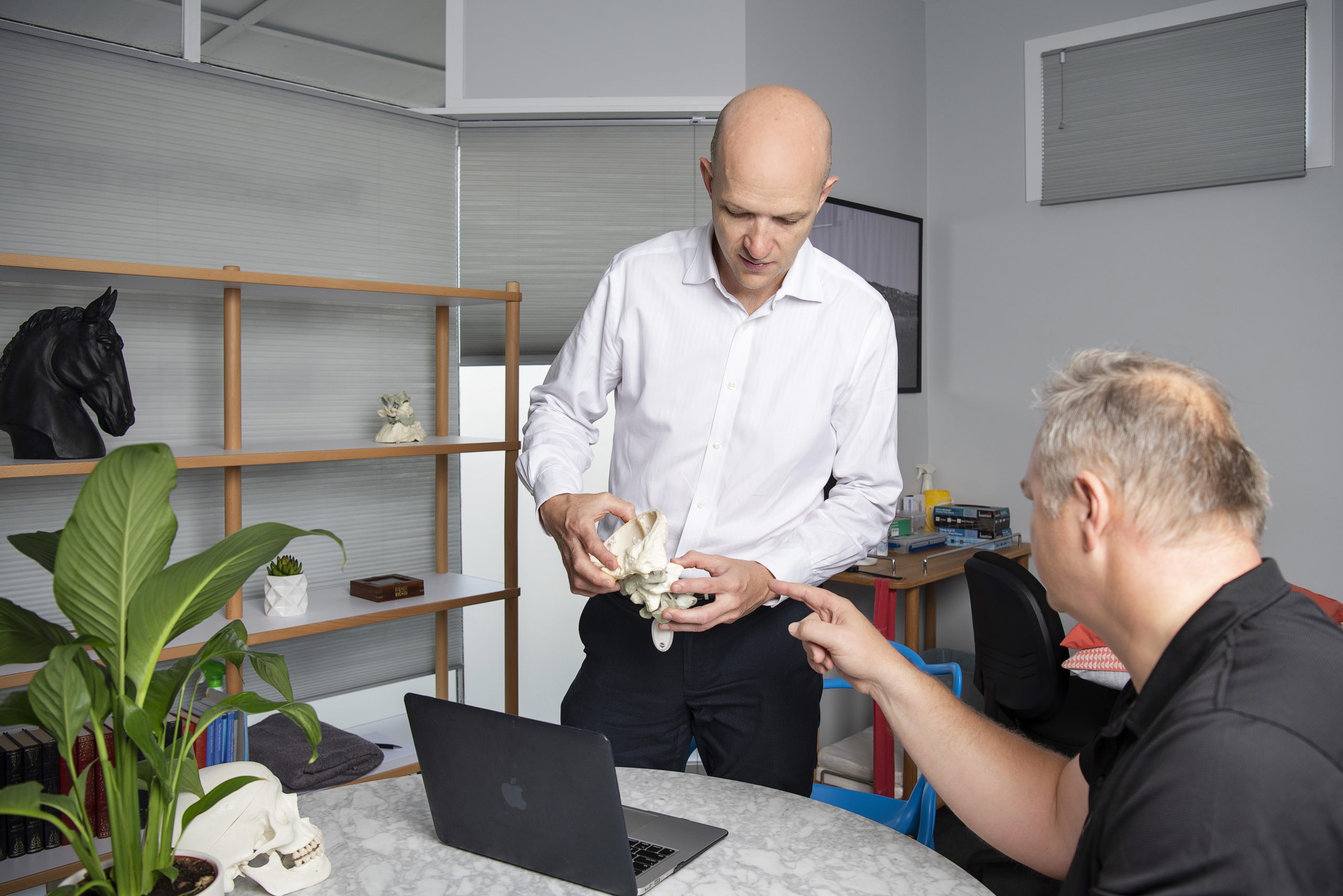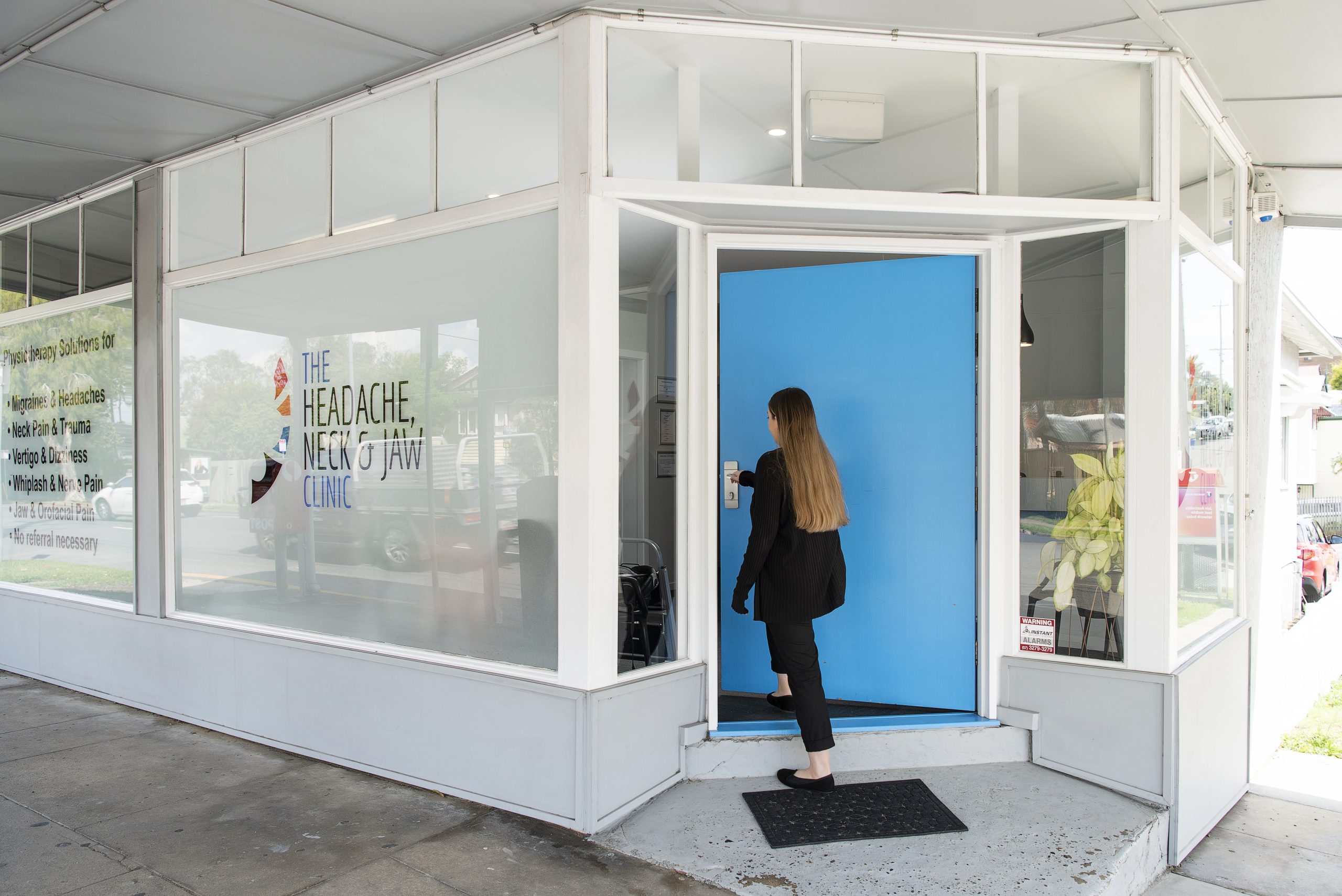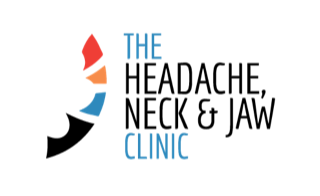TMJ Resources for Referrers

Referring a Patient? - Click Here
Degenerative Disc Disease
Osteoarthritis (OA) of the TMJ is a degenerative disease usually affecting only one side of the TMJ. The articular cartilage (disc) begins to breakdown and structural changes occur in the bone along. Symptoms include; pain, dysfunction, altered movement patters and increased crepitus. Although physiotherapy cannot prevent osteoarthritic changes, we can assist in pain management, and improving functional jaw mobility. Treatment commonly consists of TMJ joint mobilisations, muscle release and improving strength and proprioceptive awareness. Treatment for these patients is usually ongoing with appointments every 4-12 weeks depending on the patients needs.
Author: Nigel Smith
Jaw Fracture / Trauma
Depending on the type and location of fracture patients will either require surgery or a period of immobility. During this time patients are encouraged to stick to a soft/liquid diet and avoid excessive jaw movements with brushing/talking. During this period of immobility physiotherapy primarily focuses on improving upper cervical biomechanics, which is commonly a secondary source of pain following jaw trauma. The cervical spine also plays a large role in the posture, positioning and function of your jaw. Once the fracture has healed we will begin to mobilise the TMJ and retrain TMJ muscle strength, control and awareness to assist in restoring opening range and jaw function. The rehabilitation process typically takes 2-4 months, however can vary from patient to patient depending on the location of the fracture, healing rate, previous trauma etc.
Dislocated Jaw
TMJ dislocations occur when the mandibular condyle detaches from the mandibular fossa. This can occur on one or both sides simultaneously. A dislocated TMJ requires immediate medical attention. If unable to reduce the dislocation the patient may require surgery. Following reduction and/or surgery physiotherapy can assist with improving the overall strength, awareness and biomechanics of the TMJ to help minimise reoccurrence. The rehabilitation process typically takes 2-4 months, however can vary from patient to patient depending on the severity of the dislocation, previous trauma, etc.
Author: Nigel Smith
Locked Jaw
What is a Locked Jaw?
A locked jaw is when the disc dislocates anteriorly and forms a mechanical block to stop the condyle translating (sliding forward). No translation means the jaw can’t open past 25mm. The patient usually can fit no more than 2 fingers in their mouth. Any closed lock requires immediate referral to a Physiotherapist and Oral Surgeon. Physiotherapy initially focuses primarily on disc reduction and uses a variety of techniques to reduce muscle spasm, and improve condyle translation. If reduction is not achieved within 3 appointments, it is likely the patient will require an arthrocentesis performed by their Surgeon. Following reduction (whether conservatively or surgically), the patient will require immediate and ongoing rehabilitation of the TMJ to help minimise reoccurrence. Treatment depends on the patients exact assessment findings, but commonly involves joint mobilisations and strength and proprioceptive exercises to help stabilise the disc. Typically following an arthrocentesis we will see these patients twice weekly for two weeks then gradually spread their appointments apart over the coming 2-4 months until function and stability has returned.
Author: Nigel Smith
Clicking Jaw
What is a Clicking Jaw?
A click is a loss of congruency with the condyle of the jaw and the disc. Instead of having a smooth movement, the condyle sticks behind the disc and then jumps forward quickly making a joint sound. Clicking is most commonly painfree, although can be associated with acute pain. Not all clicks require intervention, however, if the click is painful or changing its nature e.g louder, harder to click, more frequent etc. it definitely requires a referral to a physiotherapist as an unstable click can progress to a locked jaw. A physiotherapist trained in TMJ, will do a full assessment of both the TMJ and upper cervical spine. Treatment depends on the assessment findings, but commonly involves joint mobilisations, and strength and proprioceptive exercises to help stabilise the joint and minimise/remove clicking where possible. Patients with a painfree click will commonly see their physiotherapist for 3-4 appointments over 6-8 weeks. Patients with a painful click will commonly see their physiotherapist for 6-7 appointments over 2-3 months.
Author: Nigel SmithTeeth Clenching
Chronic teeth clenching and grinding is a concern for many of our patients. Sometimes patients are unaware of these habits, other times they are consciously aware of the problem but are not sure how to stop it.
People can clench for a variety of reasons and part of our role at The Headache Neck & Jaw Clinic is to determine whether clenching is the cause or result of their pain or dysfunction. Clenching can be caused as a result of poor stability and control within the TMJ and/or cervical spine. The clenchers become over-dominate to try and stabilise the joint/s e.g. weakness in pterygoid musculature will lead to the temporalis becoming overactive to control lateral jaw movements. Weakness in the anterior cervical musculature will lead to overcompensation from the jaw, when we load the cervical spine by getting the patient to hold their head off the end of the bed they are no longer able to control jaw movement as the jaw parafunction is compensating to support the weight of the head. This is often associated with a forward head posture.
Clenching can also be a secondary response to things such as stress, anxiety and medication. When we have addressed the musculoskeletal component to clenching, if the patient continues to report issues we begin to discuss alternate adjunct treatment methods such as splint therapy, stress management or botox injections. These recommendations are assessed on an individual level.
Author: Nigel Smith
Definition of Diagnostic Terms
· A Derangement is an error in movement caused by a disruption of the normal articulation of the joint surfaces. i.e., an anteriorly displaced disc
· A Dysfunction is an error in movement from shortened and adapted tissues that when stretched or loaded, produce pain. e.g. increased tone in masseter limiting opening
· A Deflection is an uneven movement pattern measured during jaw opening where the jaw moves away from the midline and does not return
· A Deviation is an uneven movement pattern assessed during jaw opening where the jaw moves away from the midline, overcomes an obstruction, and then returns to the midline.
· Acute pain is of short duration (typically less than a week) and heals over time. Acute pain can lead to chronic pain
· Chronic pain is pain that the patient has been experiencing for greater than 3 months.
· Dystrophy is progressive weakening and wasting of muscle tissue.
Basic Assessments Tests and their Clinical Significance - For Dentists
Test: Active Range of Motion
Measured by: Vernier Calipers (0.0mm)
Normal: 45-55mm opening, 10-12mm lateral excursion
Significant Error: <35mm indicates significant dysfunction
Deviation/deflections from midline indicate internal derangement
Reciprocal clicking: can measure point in open and closing range clicking occurs >55mm indicates hypermobility
Influenced by: Pain, muscle spasm/tightness, capsule/ligament length, disc position
Test: Differentiation of movement: Tongue vs Jaw Muscles
Measurement: Place tongue on roof of mouth and independently open and close jaw and/or move jaw side to side without letting the tongue move from the top of the mouth
Normal: Ability open and close or move jaw side to side without involving/moving the tongue from the roof of the mouth
Significant Error:
Tongue continually drops off the roof of the mouth during opening,
Tongue actively moves in the same lateral direction the jaw is moving in,
Jaw moves in the opposite direction as instructed by the physiotherapist,
Over-active facial muscles or neck/infrahyoid muscles
Indicates:
Tongue thrusting parafunction, overactive masseters (clenching behaviour)
Inability to activate the appropriate stability muscles, particularly pterygoids
Test: Differentiation of movement: Neck vs jaw function
Measurement: Assess range and strength of depression and lateral deviation of jaw with head supported in supine, then repeat jaw movements with head unsupported, eg lying supine with head over edge of bed
Normal: No change in strength, range or joint sounds in different positions
Significant Error: Decreased range of motion or increased joint sounds, pain or difficulty in unsupported position
Indicates/Influenced By: Weakness in upper cervical spine causing compensatory parafuncton in jaw to support weight of head. It is often associated with a head forward posture.
Test: Capsule length test (Long Axis Distraction)
Measurement: End Feel Resistance in physiological and accessory planes of jaw movement determined by manually stretching the jaw joint with therapist controlling directional force.
Normal: Soft, elastic, pain free end feel
Significant Error:
Painful or hard end feel
Can be associated with loss of translation and clicking on ipsilateral side
Indicates/Influenced By:
Ligament injury or shortening, muscular spasm
Loss of vertical joint space causing compression force on in resting position, usually associated with joint derangement e.g. anterior displacement of disc
Test: Capsule length test (Lateral deviation)
Measurement:
End Feel Resistance in physiological and accessory planes of jaw movement determined by manually stretching the jaw joint with therapist controlling directional force.
Normal:
Soft, elastic, pain free endfeel
Significant Error:
Painful or hard endfeel
pain in contralateral jaw
Indicates/Influenced By:
Ligament injury or shortening, muscular spasm
Pain in contralateral jaw indicates contralateral medially displaced disc
Loss of congruency of lateral fibres of capsule and disc clicking
Tongue stroking
Test: Palpation of Muscles
Measurement:
Patients’ response to gentle and/or firm digital pressure, tone in muscles
Normal:
Pain free
Significant Error:
“Knots” or pain in muscle,
Referred pain from palpation into teeth, ear, temple face etc
Increased pain when pressure combined with active movement
Indicates/Influenced By:
Overactive/compensatory function in tender muscle group(s)
Inflammatory pain from overuse
Combination of pain in masseters with loss of tongue function and weakness in pteryoid function strong indicator for clenching/grinding habitual behaviour
Test: Palpation of Joint
Measurement:
Patients’ response to gentle and/or firm digital pressure in capsule
Feel for loss of natural Temporomandibular rhythm e.g. decreased translation
Point in range deviation/deflection occurs
Clicking/joint sounds
Normal: Pain free, even condylar movement left and right
Significant Error: Exquisite pain in posterior joint line reduced/uneven translation
Indicates/Influenced By:
Uneven translation and clicking indicates internal derangement
Exquisite pain in posterior joint line not responding to treatment indicates occlusal/splint review is necessary
Normal TMJ
Jaw Resting Position
Although the round condyle looks like a perfect fit in the articular fossa, the resting position (dictated by the disc and the length of the ligaments) has the jaw sitting in line with the peak of the articular eminence, meaning the jaw always slides forwards/backwards, rather than ascending/descending out of the fossa.
Look at the middle of the condyle as the jaw opens. It only moves in the horizontal plane, there is no vertical plane of movement. Compare this to the resting position in the Anteriorly displaced disc with reduction video.
Compartmentalised Movement
The initial movement is pure rotation of the condyle of the jaw on the disc, or movement in the inferior compartment of the joint. As the condyle moves to its limit of range, the disc and condyle lock and slide forward together creating translation. The translation moment occurs between the disc and the skull, or the superior compartment. Either of these compartments can cause an movement derangement.
Retrodiscal Tissue
This is the nerve supply and blood supply to an otherwise aneural and avascular joint. The retrodiscal tissue is clear of compression when the disc is sitting in the correct position. As the jaw opens, you can see it stretch but it always remains free of the condyle.
Alveolar Bone Density
When excessive force is applied to a sphere, the force is transferred to the centre of the sphere and it will break down from the inside out. Look at the quality, colour and density of the alveolar bone in the head of the condyle and the articular eminence and compare it to the Anteriorly displaced disc with reduction video.
On X-ray, a jaw joint under sustained compression will not necessarily show up as degeneration as you don’t see changes to the joint surface until the alveolar bone has collapsed.
Disc Position
The articular disc sits on top of the condyle like a beanie and divides the jaw into 2 compartments. It is almost hourglass or butterfly shaped and throughout the movement the condyle stays in the middle of the bulk of the tissue.
Author: Nigel Smith
Reciprocal Click or Anterior Displacement with Reduction
Jaw Resting Position
Compare the resting position of the condylar head, it is sitting backwards and upwards. The ligaments and capsule that cross the joint line have shortened and are creating compression on the disc. The discs response to compression is to displace forward creating a barrier for movement.
Overcoming this barrier under compression leads to a clicking sound, and more importantly from a diagnostic point of view, you can clearly see a second reciprocal click on closing as the condyle drops backwards off the disc. The first click is the jaw reducing back into the correct place, the closing click is moving out of place.
Compartmentalised Movement
The distinctive roles of the inferior and superior compartments have been lost, the jaw over rotates and compresses the posterior joint capsule before finally overcoming the obstruction.
Retrodiscal Tissue
When the disc is displaced forward, the retrodiscal tissue can sit across the joint surface and be compressed on basic jaw movements like chewing. This is a common source of pain referring into the ear and pain after function, remembering that the inner workings of the jaw joint are aneural and don’t have the capacity to report pain.
Alveolar Bone Density
As mention in the normal video, the alveolar bone has become compromised and lost its density and white colour.
Disc Position
Once the condyle reduces back onto the disc, you can see that even in this severely affected jaw, the condyle can still translate quite a long way forward though in this case, it would be painful as it is weight bearing on the retrodiscal tissue. This is why it is important to assess a clicking jaw that is changing its properties, as these secondary degenerative changes will be occurring without the patient necessarily feeling them.
Author: Nigel Smith
Headache, Neck & Jaw Conditions We Treat
Our Brisbane clinics specialise in the treatment of head, neck and jaw conditions, many of which are notoriously difficult to treat. If you’re experiencing symptoms of any of the following problems, our team has the expertise and training to help.
Headaches
Migraines
Jaw and Orofacial Pain
Neck Pain and Trauma
Whiplash and Nerve Pain
Vertigo & Dizziness
Tinnitus
Singing / Vocal
Therapy
Book an Appointment
If you’re experiencing pain or discomfort then don’t put it off - contact our friendly team today to make an appointment with one of our expert physiotherapists.
Book Your Appointment Now!
Get in touch with us today for more information on our services or to make an appointment with our friendly team.

